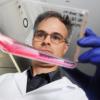Link: http://www.eurekaler...l-sos042204.php
Public release date: 22-Apr-2004
Contact: Heather Cosel
coselpie@cshl.org
Cold Spring Harbor Laboratory
Something old, something new
Scientists glean new insight from prematurely old mice
The relationship between genome integrity and aging is the subject of a new report in the upcoming issue of Genes & Development. Drs Lin-Quan Sun and Robert Arceci at Johns Hopkins University School of Medicine have developed a novel mouse model to study premature aging, and the genetic events that contribute to normal development and longevity.
"The inability of an organism to maintain the integrity of its genome has been postulated to be an important cause of aging, developmental abnormalities and predisposition to cancer," explains Dr. Arceci, corresponding author and professor of pediatrics and oncology at The Johns Hopkins Kimmel Cancer Center.
Dr. Arceci and his colleagues focused on PASG (Proliferation Associated SNF2-like Gene). PASG encodes a SWI/SNF protein family member that facilitates DNA methylation (the addition of a methyl (CH3) group to cytosine) – an effective means to silence genes in the eukaryotic genome. As an organism develops, global patterns of DNA methylation change in order to accommodate the changing patterns of gene expression.
Now, for the first time, Drs Sun and Arceci provide in vivo evidence that the loss of PASG results in a reduced level of global genomic methylation and premature aging in mice.
"In order to elucidate the function of PASG, we generated a "knockout" mouse carrying a hypomorphic mutation of PASG. Using homologous recombination, exons 10, 11 and 12 containing helicase domains II, III and IV were deleted," states Dr. Arceci.
These PASG-mutant mice displayed numerous abnormalities, including developmental growth retardation and characteristics associated with premature aging, including graying and loss of hair, reduced skin fat deposition, osteoporosis, cachexia and, ultimately, an untimely death. On a cellular level, PASG-mutant animals displayed reduced levels of genomic methylation, as well as increased expression of senescence-associated tumor suppressor genes, like p16INK4a.
Dr. Arceci is hopeful that "the mutant mice provide a potentially useful model for the study of aging as well as the mechanisms regulating epigenetic patterning during development and postnatal life. They may also serve as a potential model for examining the role of epigenetic change and chromatin remodeling in cancer predisposition with implications for possible therapeutic targeting."
###
Edited by Kevin Perrott, 11 April 2006 - 01:53 PM.



















































